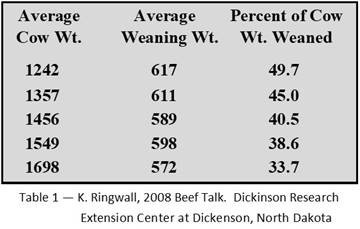According to the USDA Research Center in Clay Center, Nebraska, the average Angus, Red Angus and Hereford cow in America weighs over 1,400 pounds. WOW! The status quo seedstock industry has successfully out-Simmentalled the Simmentals. Unfortunately, as cow size has increased, profitability has decreased. It doesn’t matter how big your cattle are if they’re not profitable.
Why are cows as big as they are?
For the past 50 years… the status quo beef industry has focused almost single-mindedly on increasing production per cow (weaning weight). Although this has provided some bragging rights, it has been very detrimental to ranch profits. As individual weaning weights increase, pounds and profit per acre decrease. Average cow-calf producers of today are much less profitable than they were 50 years ago – and it continues to get worse.
Since big cows need to eat substantially more than smaller cows just to meet their maintenance requirements, producers have been forced to reduce stocking rates and/or to increase supplemental feeding. With the cost of land and feed as high as they are, it is quickly becoming less and less profitable to own those big, high-maintenance cows. Ask your banker if he thinks you should focus on bragging rights or on profit.
Since smaller cows need to eat less to meet their maintenance requirements and since they are able to wean a higher percentage of their own body weight, they will always produce more total pounds and more total profit than big cows – on the exact same acres. To add insult to injury, there is growing evidence that smaller cows will actually wean bigger calves than big cows in a real-world, unpampered environment (see table below).

Notice… as cow size increases, weaning weights decrease. This is the exact opposite of what most people would expect to happen. After all, the reason everyone has big cows is to increase individual weaning weights.
So, what happened? How can this be?
The big cows do NOT fit their environment! Your ranch can only support so much growth, frame and milk. Once you go beyond that point, you will have to provide expensive supplementation to meet the needs of your big, high-maintenance cows. Without expensive supplementation, your weaning weights and your conception rates will suffer. Maintenance requirements must be met before any weight gain or reproduction can take place.
It shouldn’t surprise you that most of the bulls being sold today were produced by high-maintenance, 5 to 7-frame cows that weigh 1400 to 1800 pounds. These cows must be pampered to stay in production. What size and type of replacement females will these bulls produce? Like begets like! If you are concerned about long-term profit, then thick, easy-fleshing, low-maintenance, 3 to 4-frame cows that weigh 1100 to 1250 pounds are plenty big enough (pictured below).
These 10-year-old Solar Cows are very feminine in appearance. They are wedge-shaped – and they carry a tremendous amount of thickness and condition. Even during a severe drought, with calves at side, they met their maintenance requirements and were able to store up energy in the form of fat. They were ready to re-breed 30 days prior to our breeding season.
Only problem is a 1000# cow will produce a finished steer of 1100# and packers say that is to light. (unless you do not start the finish program until they reach 1000# which is very inefficient
Dan, as stated in the article above, our 3 and 4-frame cows have a mature weight of 1100 to 1250 pounds. Their calves will finish (grade choice) at 1250 pounds on grass — bigger in the feedlot. Most of our customers stopped worrying about making the feedlots and the packers more profitable. They focus on making their own business more profitable, enjoyable and sustainable.
while we believe in and practice running moderate framed cows we find that we suffer at the sales yard. the buyers just about always discount our calves because they don’t meet what the feedlots/packers want. we grass finish some of our calves and sell them locally and they usually dress out at anywhere from 650-800 lbs., but it takes us about 24 months to reach that weight. we live in a very northern climate (central interior of British Columbia) and have short summers and long winters but our summer grass is some of the best i have ever seen.
Doug, we have been selling 900 to 1000 bulls every year. I estimate 10 to 20 percent of PCC-sired calves go into grass finishing programs. We can hit those carcass weights on grass alone in 21 to 22 months. It takes less time in a feedlot. The remaining 80 to 90 percent of the PCC-sired calves go through the traditional livestock auctions, feedlots and packing plants. That is several thousand calves every year. Since we have a very high rate of repeat customers, I have to assume that no one is being heavily discounted. It is all about YOUR bottom line and net profit.